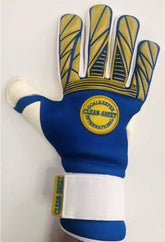Sharpening Goalkeeper Reflexes: Science-Backed Drills to Master Reaction Time
Why Reaction Time Matters for Goalkeepers
In the fast-paced world of soccer, goalkeepers don’t just stop shots—they predict them. A split-second delay in reacting to a penalty kick or a deflection can be the difference between a match-winning save and conceding a goal. Reaction time isn’t just a natural gift; it’s a skill that can be trained and refined.
At Clean Sheet International, we specialize in goalkeeper training programs that harness the power of sports science to improve reflexes and agility. Whether you're a youth goalkeeper in Montreal or a professional looking to sharpen your edge, understanding and optimizing reaction time is critical.
What is Reaction Time in Goalkeeping?
Reaction time is the interval between a stimulus (like a shot on goal) and the goalkeeper’s physical response (like diving or moving to block the shot). It involves three core components:
- Sensory Input: Detecting visual, auditory, or tactile cues.
- Cognitive Processing: Deciding how to react.
- Motor Output: Executing the save.
Average Reaction Times: How Do You Compare?
To put things into perspective, here’s how goalkeepers stack up against other athletes and the general population:
| Group | Average Reaction Time |
|---|---|
| Professional Goalkeepers | 200-250 ms |
| Amateur Goalkeepers | 250-300 ms |
| General Population | 300-350 ms |
Professional goalkeepers like Thibaut Courtois and Alisson Becker have honed their reaction times through specialized drills and consistent training. The good news? With the right methods, you can improve your reaction speed, too.
The Science Behind Reaction Time Improvement
1. Neural Adaptation Through Repetition
The brain forms stronger, faster neural pathways when you repeat reaction-based drills. Think of it like upgrading your brain’s “hardware” to process stimuli more efficiently.
2. Cognitive Load Training
Introducing multiple stimuli (like combining visual and auditory cues) helps goalkeepers process information faster during high-pressure situations.
3. Muscle Memory
Reflex training engrains specific movements into your muscle memory, making your responses automatic and instantaneous.
Top Drills to Improve Reaction Time
1. Reaction Ball Drills
A reaction ball is an irregularly shaped ball that bounces unpredictably, forcing goalkeepers to react quickly.
- How to Perform: Drop the ball from chest height and attempt to catch it after the first bounce.
- Pro Tip: Increase the challenge by using two balls simultaneously.
2. Strobe Light Reflex Training
Wearing strobe glasses limits your visual input, making your brain work harder to track the ball.
- How to Perform: Perform standard catching drills while wearing strobe glasses, focusing on timing and hand-eye coordination.
3. Close-Range Deflection Drills
Stand just a few meters away from a coach or teammate who deflects balls toward the goal using a paddle or board.
- How to Perform: React to unexpected deflections, focusing on quick footwork and hand movement.
4. Multi-Stimulus Training
Combine visual and auditory cues for a comprehensive reaction test.
- How to Perform: A coach shouts a number of claps while shooting the ball, forcing you to process both cues simultaneously.
Calculating Your Reaction Time
Want to track your progress? Here's a simple formula:
Reaction Time (ms) = (Distance Moved / Speed of Stimulus) × 1000
For example, if you react to a shot fired from 12 meters away at 20 m/s:
Reaction Time = (12 / 20) × 1000 = 600 ms
After consistent training, you should aim to reduce this time significantly!
Weekly Reaction Time Progress Tracker
Consistency is key. Track your progress using this compact weekly chart:
| Week | Drill | Reaction Time | Improvement |
|---|---|---|---|
| 1 | Baseline Test | 280 ms | – |
| 2 | Reaction Ball Drill | 265 ms | -15 ms |
| 3 | Strobe Light Reflex Training | 255 ms | -10 ms |
| 4 | Light & Sound Stimulus Drill | 250 ms | -5 ms |
| 5 | Close-Range Deflection Drill | 240 ms | -10 ms |
| 6 | Rapid-Fire Shot Drill | 235 ms | -5 ms |
| 7 | Game Scenario Reflex Test | 230 ms | -5 ms |
| 8 | Final Combined Test | 225 ms | -5 ms |
Real-World Reaction Times: How Do You Compare to the Pros?
Let’s compare with some of the world’s best goalkeepers:
| Goalkeeper | Reaction Time (ms) | Notable Achievement |
|---|---|---|
| Manuel Neuer | 200 ms | Known for sweeping up and quick reflexes |
| Thibaut Courtois | 210 ms | Heroic saves in UEFA Champions League Finals |
| Alisson Becker | 220 ms | Crucial saves for Liverpool in key matches |
| David de Gea | 230 ms | Renowned for lightning-fast reflex saves |
Why Train With Clean Sheet International?
- Tailored Programs: For youth, amateur, and professional goalkeepers in Montreal and surrounding areas like Laval and Longueuil.
- Sports Science Integration: Video analysis, reflex tracking, and cognitive load training are part of every session.
- Year-Round Training: Flexible programs in summer and winter with weekday and weekend options.
Join the Best Goalkeeper Training in Montreal Today!
Ready to improve your reflexes and become a goalkeeping powerhouse? Join our weekly or monthly programs and track your performance like the pros!
📍 Boost your reaction time with expert goalkeeper drills. Based in Montreal, serving goalkeepers across the region.




